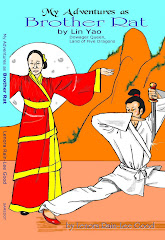Anyhow, I’d promised you my rant, uh, essay, on Footnotes, so here it is, all 717 words.
Footnotes
--Lenora Rain-Lee Good
Remember footnotes--those notes in tiny print under a black line at the foot of the page? What ever happened to them? Where did they go? Did they get tired of hanging onto the black line and slide off the page to be eaten by the dust bunnies under the bed?
I read a lot of nonfiction, and I read it for enjoyment as much as to learn, and because I read everything, I read the footnotes. When they were at the bottom of the page it required a quick glance, mere seconds, to determine whether or not to read them.
Footnotes now only exist when I type them. If I write them, I know what they say and I don’t need to glance to the bottom of the page, except when I proof what I’ve just written.
Now, someone in his infinite wisdom – probably someone who isn’t a ‘true reader’ – has changed the publishing of books. Footnotes are passé. They are old fashioned. They are “Nota non grata.” They have become the red headed orphan. Why?
The best answer I’ve found is a slam to all who are not working in academia. Footnotes have migrated to endnotes because some people found them irritating and in the way, and no one but academes read them anyway, so why not put them in the back, out of the way, allowing the text to flow more beautifully. Say what?
In an era when the mantra is “time is money,” and more and more items are on the market to save time, and take our money, why have books devolved into endnotes? Time, like money, is not to frivolously twitter away on endeavors of questionable quality. Like endnotes.
Now, instead of one bookmark, and mere seconds to scan a footnote to determine whether it’s something to read or not, I have to flip to the back of the book and find the endnotes. I now need two bookmarks (I actually read one book that required three book marks. I admit, it was a textbook of sorts, so some silliness could be expected). Every time I come to one of the small, superscript numbers in the text, I must now stop reading, disrupt the “beautiful flow of words,” hold my place, go to the back, scan until I find the matching number, and determine whether or not to read the note. Then I must go back to the text and find my place, because by then, I’ve moved my finger and lost track of which line I was reading. This process no longer takes mere seconds.
Admittedly, some authors are kind enough to use end notes as bibliography notes, with no text – a quick scan and I can tell I don’t need to keep up the flipping and flapping of pages. And, sometimes, I can scan down the notes and make a mental note that I don’t need to check them until I get to number 347. However, there is frequently good information in the notes that I don’t want to miss.
And chapter endnotes? I hope the person who came up with that idea spends eternity flipping through pages trying to quickly find the end of the chapter. Eternity is a long time. He may get his just rewards. (I hope he sits next to the person who invented white baby shoes, and is spending his eternity polishing them.)
I don’t believe the argument that paper is saved any more than I believe that non-academic readers aren’t interested in footnotes.
Had I learned to enjoy reading while sitting in a chair, possibly at a table, endnotes might not hold the dire amounts of frustration they do. Yes, I learned to read sitting in a chair at a desk, but for pure enjoyment, my favorite way to read a book is stretched out on my back in bed. Or on the couch. Or maybe a hammock. And, at my age, I’ve earned the right to read where I want to. If it’s technical, or job related, I read at my desk. But I don’t have a job any more. I’m retired.
Footnotes. One of many things that have quietly slipped into the history box labeled “The good old days” of which I am more and more convinced does exist--somewhere.
THE END
Coming soon: My Adventures as Brother Rat will be available at: www.samsdotpublishing.com on 1 July 2009, it will be published as a quality Trade Paperback.






No comments:
Post a Comment